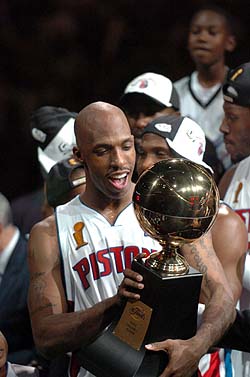Regardless of any temporary unavoidable absence, the Quest is in this for the very long term—indefinitely, for many, many years ahead. Count on us for being right where basketball is at, which is here, damn it.
Anyone who has been here over for many months / a couple of years knows that, unfortunately, Quest sometimes has “low times” when no Reports appear for several weeks. But then they start appearing at a pretty good rate again, as long, as high quality, as unique, and as stubbornly independent as always. The inconsistency of production is just in effect another unusual feature of a Site that has a lot of unusual features.
Guess what we have for you Quest sojourners now? We have the promised substantial tweaking of Real Player Rating (RPR) formulas, to bring them closer still to perfection.. Here are some highlights of the adjustments to the ratings:
--The average RPR among all players in the NBA who play at least 300 minutes during the regular season will be very close to .700. The average RPR of those players in 2008-09 was .691; we decided to round up and make it a nice easy to remember, even number. You can expect that there will be between 365 and 385 players who play at least 300 minutes. The evaluation scales are being slightly tweaked to reflect the very slightly higher RPRs.
The hidden defending component, and thus RPR as a whole, is not fully valid unless a player has played at least 300 minutes, and validity of the hidden defending rating approaches perfection as minutes approach 1,000 or so. Therefore, team RPRs are generally not done until starting the first of February.
However, there is also “Basic Real Player Rating (BRPR),” which has everything in RPR except hidden defending. BRPR can be done validly with as few as 100 minutes of playing time logged. BRPR is always necessary if a contending team RPR report for a particular month is done, for example, the Los Angeles Lakers in December 2009 or the Boston Celtics in March 2010.
--The combined total of hidden defending and scored defending will now be calibrated as 45% of the total RPR. The offensive production, all of which is scored, will now be calibrated as 55% of the total RPR. In 2008-09, that breakdown was about 58% offense to 42% defense. It is believed that basketball both historically and under current League outlook and policy is a game that is slightly biased in favor of offense, thus the slight extra weight put on the offensive factors in RPR.
It is not by any means impossible or grossly difficult to win a Ring with a defense first policy. For example, the Boston Celtics just did it in 2008. But if you try to win a Ring with defense, you can’t ignore offense or operate an unqualified offense (that’s you, Denver, you unqualified offense users you, laugh out loud). But it is a little more tricky and difficult to win a Ring with a defense first team skill set and team policy.
As of right now, the one and only reason we are projecting Lakers 4 and Celtics 3 instead of Celtics 4 and Lakers 3 in the 2010 Championship is this very reality that we strongly believe to be true. But obviously, any 4-3 playoff projection could turn out the other way and it would not be a big shock. And so far, incidentally, the Celtics’ defense is truly awesome.
Here are the out of the gate team defensive efficiencies by team:
2009-10 DEFENSIVE EFFICIENCY OF NBA TEAMS
As of November 13, 2009
Points Allowed per 100 Possessions
Milwaukee Bucks 93.1
Boston Celtics 93.7
Oklahoma City Thunder 97.3
Miami Heat 99.3
Charlotte Bobcats 99.4
Cleveland Cavaliers 99.8
Portland Trail Blazers 100.2
Indiana Pacers 101.0
Dallas Mavericks 101.5
Chicago Bulls 101.6
Los Angeles Lakers 101.9
Detroit Pistons 102.9
Houston Rockets 104.9
Los Angeles Clippers 105.1
LEAGUE AVERAGE 105.4
New Jersey Nets 105.8
Washington Wizards 106.0
Orlando Magic 106.8
Atlanta Hawks 106.9
Denver Nuggets 108.0
Phoenix Suns 109.3
New York Knicks 109.4
Philadelphia 76ers 109.5
Golden State Warriors 109.9
San Antonio Spurs 110.2
Sacramento Kings 110.8
Utah Jazz 110.9
Minnesota Timberwolves 111.6
New Orleans Hornets 113.5
Memphis Grizzlies 116.3
Toronto Raptors 116.8
Wow, Kevin Garnett, Rajon Rondo, Paul Pierce and company, what a blazing defensive start! You want that second ring bad. Note that so far, two teams that had great defenses last year, the Orlando Magic and the Denver Nuggets, have yet to establish one this year. Note also the bad defensive start of the New Orleans Hornets. For those surprised by the firing of Hornets' Coach Byron Scott, you can see some justification for that right here. A head coach is always partly responsible if a team is tanking badly on defense.
Now back to the RPR adjustments:
--The breakdown between hidden defending and scored defending will be calibrated as 45% hidden defending and 55% scored defending. Last year the breakdown was about 40% hidden and 60% scored. Note that hidden defending as a percentage of total RPR will average .45*.45 or .2025, slightly over 20%. For defensive specialists, the hidden defending rating could now possibly constitute as much as about 35% of the entire RPR, with that defensive specialist’s overall defending rating constituting as much as about 2/3 of his entire RPR.
--Recent research is showing an even higher correlation than was expected between assists and playoff wins, so the planned increase in the RPR factor for assists was increased, so that the assist factor was raised substantially, from 1.75 to 2.15.
--On the other hand, research is showing that there is a smaller correlation than was expected between turnovers and playoff losses. Apparently, turnovers are not as bad for a top pro team as many would think they are. The turnover factor was slightly reduced from -2.00 to -1.95.
--The free throw shooting factors were substantially tightened up. Missed free throws are actually a fairly serious matter, especially if you are playing a team that is defensively bent on piling up a large number of fouls (yes, that’s you Denver). Whereas last year the threshold, the percentage of shots that have to be made for a positive impact on RPR was only 45% for free throws, this year it is 57%, Specifically, a made free throw is exactly 1.00 in terms of RPR while a missed free throw is -1.3256.
--Offensive rebounding was upgraded from 1.25 to 1.43; defensive rebounding was little changed, and is now 1.31.
--Blocks were upgraded from 1.6 to 1.8. Steals were slightly upgraded from 2.2 to 2.3. Steals carry a very high payload due to how often they lead to easy or relatively easy scores.
The “penalty” for personal fouls was very slightly increased from .9 to 1.0.
--All points scored remain at par: each point scored equals an RPR point. The bonuses (upward adjustments) were left unchanged for threes and virtually unchanged for free throws. The bonus for a made two was reduced from .6 to .4 to better calibrate this shot with other shots and plays. Under the new, close to perfect RPR system, the following thresholds, or percentage of shots that must be made for there to be a positive impact on RPR, exist:
3-Point Shot: 20.0%, approximately .167 less than the League average.
2-Point Shot 30.0%, approximately .185 less than the League average
Free Throw: 57.0%, approximately .200 less than the League average.
In summary, the 2009-10 RPR formulas and calibrations represent state of the art understanding of the value of each action on the court in NBA playoff games. The RPR system has now been carefully calibrated across every relevant dimension. Tweaking in future years will almost inevitably be much smaller than this year’s tweaks.
So now you can look for Real Player Ratings popping up all over the place: to review games, to cover teams, to show a player’s career history, and for the NBA as a whole. The mid-season NBA-wide RPR report is due out in very late February or in the first week of March.
See the 2009 Production Plan of what we would like to produce, at least some of which we actually do produce. As any regular knows, unfortunately, that Plan is substantially wishful thinking for various impossible to change reasons.
Finally, we will within 48 hours be changing the User Guide for Real Player Ratings to reflect the latest adjustments.








